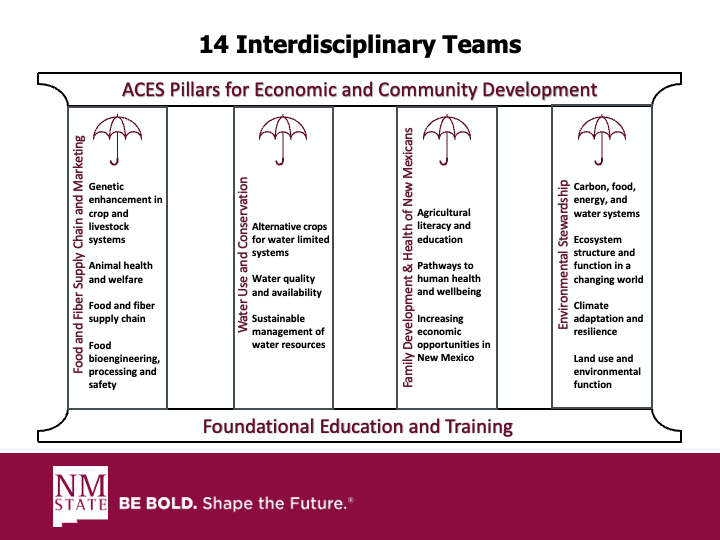Types of Experiment Station Projects
Capacity Projects
An important source of funding for the College of ACES are legislatively authorized capacity funds, sometimes called Hatch Funds. The federal dollar amounts allocated to each state, including New Mexico, depend on variables such as rural population, farm population, forest acreage, and poverty rates. These funds, and matching state funds, strengthen ACES' capacity to hire excellent faculty researchers.
AES creates research capacity by underwriting the salaries of ACES researchers with these capacity funds. Federal law requires that these researchers document their research by establishing a project and providing annual reports, based on the goals and objectives of their projects.
A NIFA capacity-funded project is any agricultural research project which is supported by dollars from one of the following five programs:
- Hatch (1862 LGUs only) (Also known as "Umbrella Projects" at NMSU)
- Hatch Multistate (1862 LGUs only)
- McIntire-Stennis
- Animal Health
- Renewable Resources Extension
Hatch projects
Individual, or small group projects working towards a common objective. Researchers at NMSU are engaged in Umbrella Projects, which are collaborative team-based research projects, instead of the individual Hatch projects. If a researcher feels that their specific area of research cannot be covered with the existing Umbrella topics, they can reach out to their department head and the AES Associate Director for further guidance.
Who needs one? Any AES faculty with a .25 FTE or higher is required to have an active project; unless determined otherwise by their department head and/or AES Director.
Umbrella Projects
These are multidisciplinary collaborative projects that were developed in 2023. This approach is mean to encompass current and emerging areas of research within the College of ACES.

Hatch Multistate Projects
Multi-state projects are monitored and approved by Dr. Lara Prihodko, AES Associate Director. Each project will need to be initiated and maintained through the NIFA Reporting System (NRS) and NIMSS. The two systems do not link together and approval and reporting needs to be completed in both systems.
To become active on a multi-state project, please contact Dr. Lara Prihodko. You will need to provide a completed Appendix E from NIMSS, the objectives you plan to address, and which knowledge Area, Subject of Investigation, and Field of Science that best describes your research. Click here for the Manual of Classification provided by NIFA.
Animal Health Projects
This capacity funding supports research activities into animal health and diseases. The department head for Animal Science oversees the capacity funding for these projects. Once you have your department head's approval to propose an Animal Health and Disease capacity project, please contact Claire Montoya for instructions.
McIntire-Stennis Projects
This capacity funding supports research in one of these areas:
- Reforestation and land management;
- Forest and watershed management;
- Forest and rangeland management;
- Management of forest lands for outdoor recreation;
- Protections of forest and resources against fire, insects, disease, etc;
- Utilization of wood and other forest-related products;
- Development of land management policies; and
- Studies promoting fullest and most effective use of forest resources.
If you are interested in writing a proposal for a McIntire-Stennis project, speak with your department head and then contact Dr. Lara Prihodko and Claire Montoya.
USDA/NIFA GRANT PROJECTS (Non-capacity funding)
If you apply for and receive a competitive grant award from the USDA that is administered by NIFA, such as an AFRI grant, you will need to initiate an associated project in REEport. Your grant reporting will also be done in REEport. Do not create your own project initiation. NIFA will place a project initiation shell in your REEport draft folder, within a few days of notifying you of your award.